Financial Accounting Report: IFRS, Asset Valuation, and Theories
VerifiedAdded on 2021/06/17
|12
|2488
|44
Report
AI Summary
This report provides a comprehensive analysis of financial accounting principles, focusing on the application of International Financial Reporting Standards (IFRS) and asset valuation methodologies. The report critically examines criticisms of current financial accounting standards, particularly concerning their relevance and faithfulness in representing economic realities, as highlighted in the provided article. It delves into the conceptual framework of financial reporting, emphasizing key characteristics such as comparability, relevance, and faithful representation. Furthermore, the report explores various regulatory theories, including the public interest theory, capture theory, and the economic interest group theory, to understand the influences shaping accounting practices. The report also analyzes the implications of FASB Statement No. 144 regarding asset impairment and the motivations behind decisions not to revalue assets, along with their effects on financial statements and shareholder wealth.
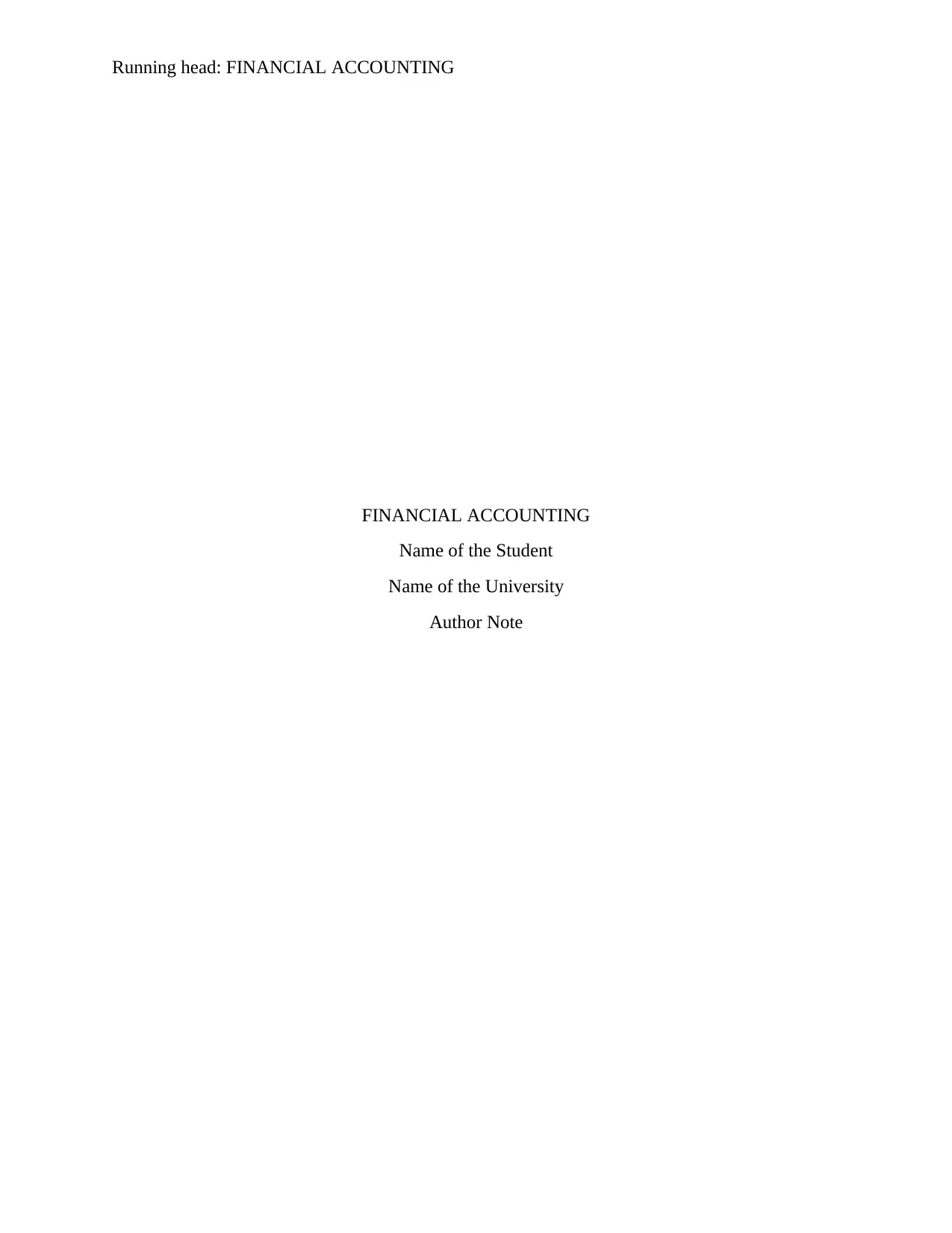
Running head: FINANCIAL ACCOUNTING
FINANCIAL ACCOUNTING
Name of the Student
Name of the University
Author Note
FINANCIAL ACCOUNTING
Name of the Student
Name of the University
Author Note
Paraphrase This Document
Need a fresh take? Get an instant paraphrase of this document with our AI Paraphraser
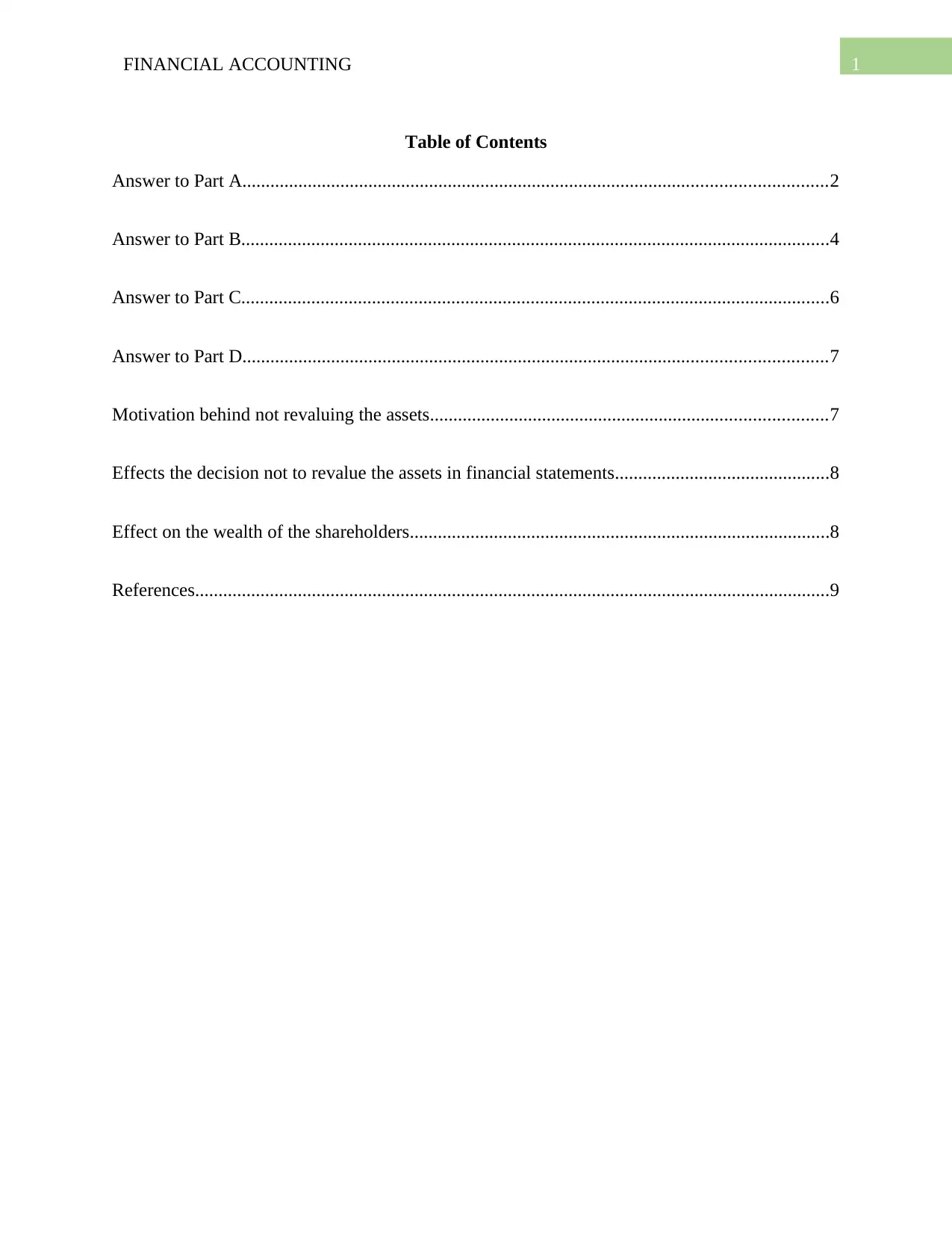
1FINANCIAL ACCOUNTING
Table of Contents
Answer to Part A.............................................................................................................................2
Answer to Part B..............................................................................................................................4
Answer to Part C..............................................................................................................................6
Answer to Part D.............................................................................................................................7
Motivation behind not revaluing the assets.....................................................................................7
Effects the decision not to revalue the assets in financial statements..............................................8
Effect on the wealth of the shareholders..........................................................................................8
References........................................................................................................................................9
Table of Contents
Answer to Part A.............................................................................................................................2
Answer to Part B..............................................................................................................................4
Answer to Part C..............................................................................................................................6
Answer to Part D.............................................................................................................................7
Motivation behind not revaluing the assets.....................................................................................7
Effects the decision not to revalue the assets in financial statements..............................................8
Effect on the wealth of the shareholders..........................................................................................8
References........................................................................................................................................9
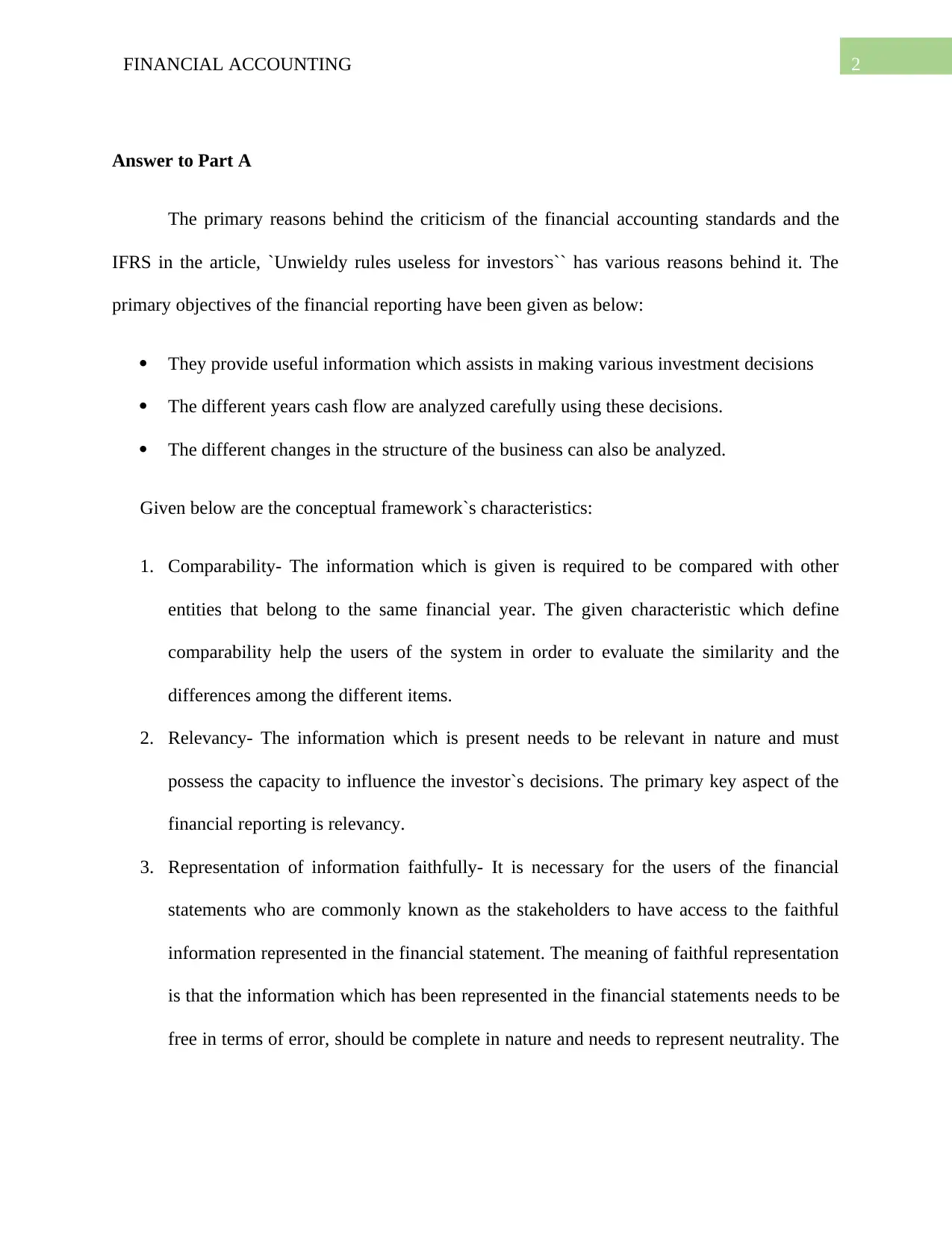
2FINANCIAL ACCOUNTING
Answer to Part A
The primary reasons behind the criticism of the financial accounting standards and the
IFRS in the article, `Unwieldy rules useless for investors`` has various reasons behind it. The
primary objectives of the financial reporting have been given as below:
They provide useful information which assists in making various investment decisions
The different years cash flow are analyzed carefully using these decisions.
The different changes in the structure of the business can also be analyzed.
Given below are the conceptual framework`s characteristics:
1. Comparability- The information which is given is required to be compared with other
entities that belong to the same financial year. The given characteristic which define
comparability help the users of the system in order to evaluate the similarity and the
differences among the different items.
2. Relevancy- The information which is present needs to be relevant in nature and must
possess the capacity to influence the investor`s decisions. The primary key aspect of the
financial reporting is relevancy.
3. Representation of information faithfully- It is necessary for the users of the financial
statements who are commonly known as the stakeholders to have access to the faithful
information represented in the financial statement. The meaning of faithful representation
is that the information which has been represented in the financial statements needs to be
free in terms of error, should be complete in nature and needs to represent neutrality. The
Answer to Part A
The primary reasons behind the criticism of the financial accounting standards and the
IFRS in the article, `Unwieldy rules useless for investors`` has various reasons behind it. The
primary objectives of the financial reporting have been given as below:
They provide useful information which assists in making various investment decisions
The different years cash flow are analyzed carefully using these decisions.
The different changes in the structure of the business can also be analyzed.
Given below are the conceptual framework`s characteristics:
1. Comparability- The information which is given is required to be compared with other
entities that belong to the same financial year. The given characteristic which define
comparability help the users of the system in order to evaluate the similarity and the
differences among the different items.
2. Relevancy- The information which is present needs to be relevant in nature and must
possess the capacity to influence the investor`s decisions. The primary key aspect of the
financial reporting is relevancy.
3. Representation of information faithfully- It is necessary for the users of the financial
statements who are commonly known as the stakeholders to have access to the faithful
information represented in the financial statement. The meaning of faithful representation
is that the information which has been represented in the financial statements needs to be
free in terms of error, should be complete in nature and needs to represent neutrality. The
⊘ This is a preview!⊘
Do you want full access?
Subscribe today to unlock all pages.

Trusted by 1+ million students worldwide
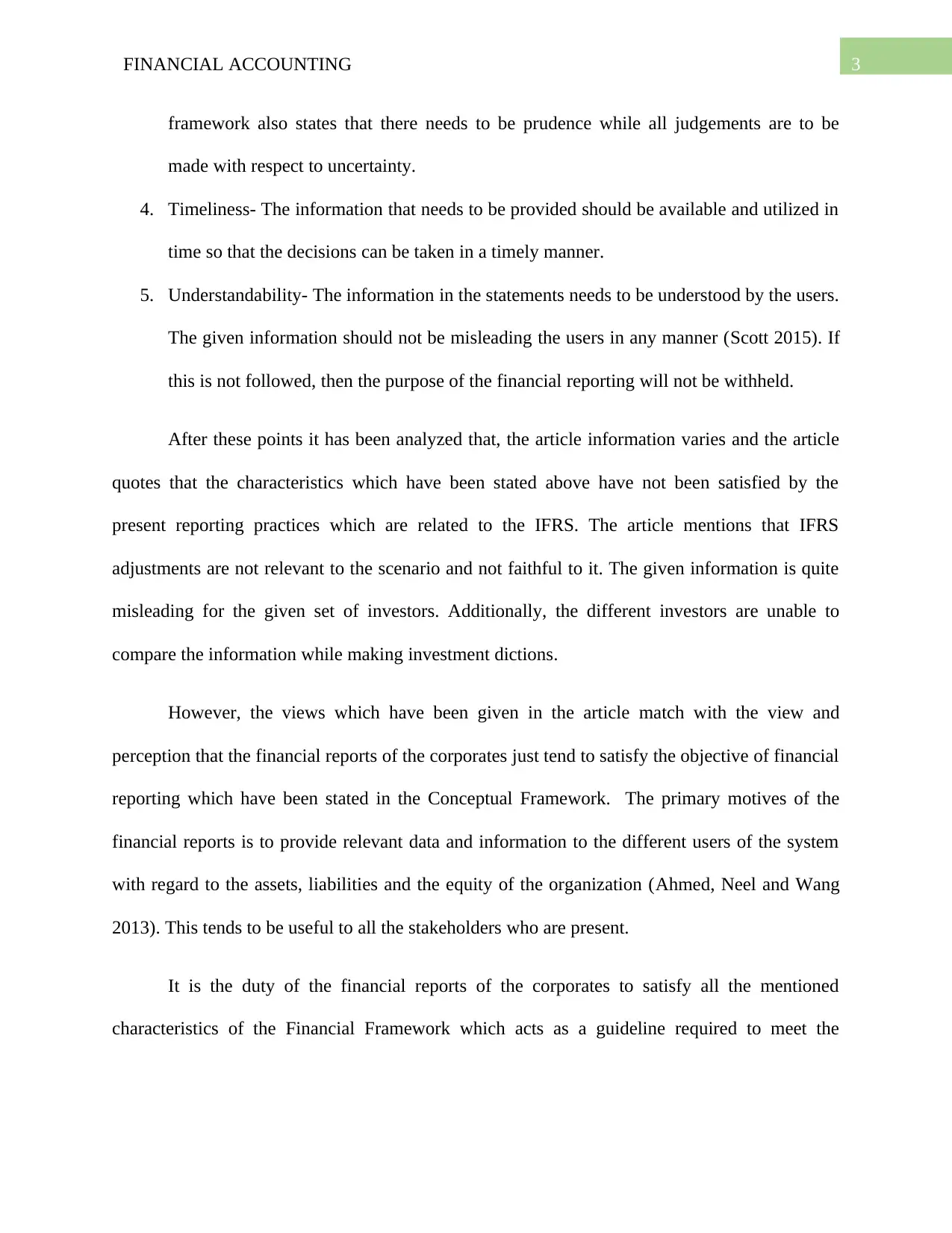
3FINANCIAL ACCOUNTING
framework also states that there needs to be prudence while all judgements are to be
made with respect to uncertainty.
4. Timeliness- The information that needs to be provided should be available and utilized in
time so that the decisions can be taken in a timely manner.
5. Understandability- The information in the statements needs to be understood by the users.
The given information should not be misleading the users in any manner (Scott 2015). If
this is not followed, then the purpose of the financial reporting will not be withheld.
After these points it has been analyzed that, the article information varies and the article
quotes that the characteristics which have been stated above have not been satisfied by the
present reporting practices which are related to the IFRS. The article mentions that IFRS
adjustments are not relevant to the scenario and not faithful to it. The given information is quite
misleading for the given set of investors. Additionally, the different investors are unable to
compare the information while making investment dictions.
However, the views which have been given in the article match with the view and
perception that the financial reports of the corporates just tend to satisfy the objective of financial
reporting which have been stated in the Conceptual Framework. The primary motives of the
financial reports is to provide relevant data and information to the different users of the system
with regard to the assets, liabilities and the equity of the organization (Ahmed, Neel and Wang
2013). This tends to be useful to all the stakeholders who are present.
It is the duty of the financial reports of the corporates to satisfy all the mentioned
characteristics of the Financial Framework which acts as a guideline required to meet the
framework also states that there needs to be prudence while all judgements are to be
made with respect to uncertainty.
4. Timeliness- The information that needs to be provided should be available and utilized in
time so that the decisions can be taken in a timely manner.
5. Understandability- The information in the statements needs to be understood by the users.
The given information should not be misleading the users in any manner (Scott 2015). If
this is not followed, then the purpose of the financial reporting will not be withheld.
After these points it has been analyzed that, the article information varies and the article
quotes that the characteristics which have been stated above have not been satisfied by the
present reporting practices which are related to the IFRS. The article mentions that IFRS
adjustments are not relevant to the scenario and not faithful to it. The given information is quite
misleading for the given set of investors. Additionally, the different investors are unable to
compare the information while making investment dictions.
However, the views which have been given in the article match with the view and
perception that the financial reports of the corporates just tend to satisfy the objective of financial
reporting which have been stated in the Conceptual Framework. The primary motives of the
financial reports is to provide relevant data and information to the different users of the system
with regard to the assets, liabilities and the equity of the organization (Ahmed, Neel and Wang
2013). This tends to be useful to all the stakeholders who are present.
It is the duty of the financial reports of the corporates to satisfy all the mentioned
characteristics of the Financial Framework which acts as a guideline required to meet the
Paraphrase This Document
Need a fresh take? Get an instant paraphrase of this document with our AI Paraphraser
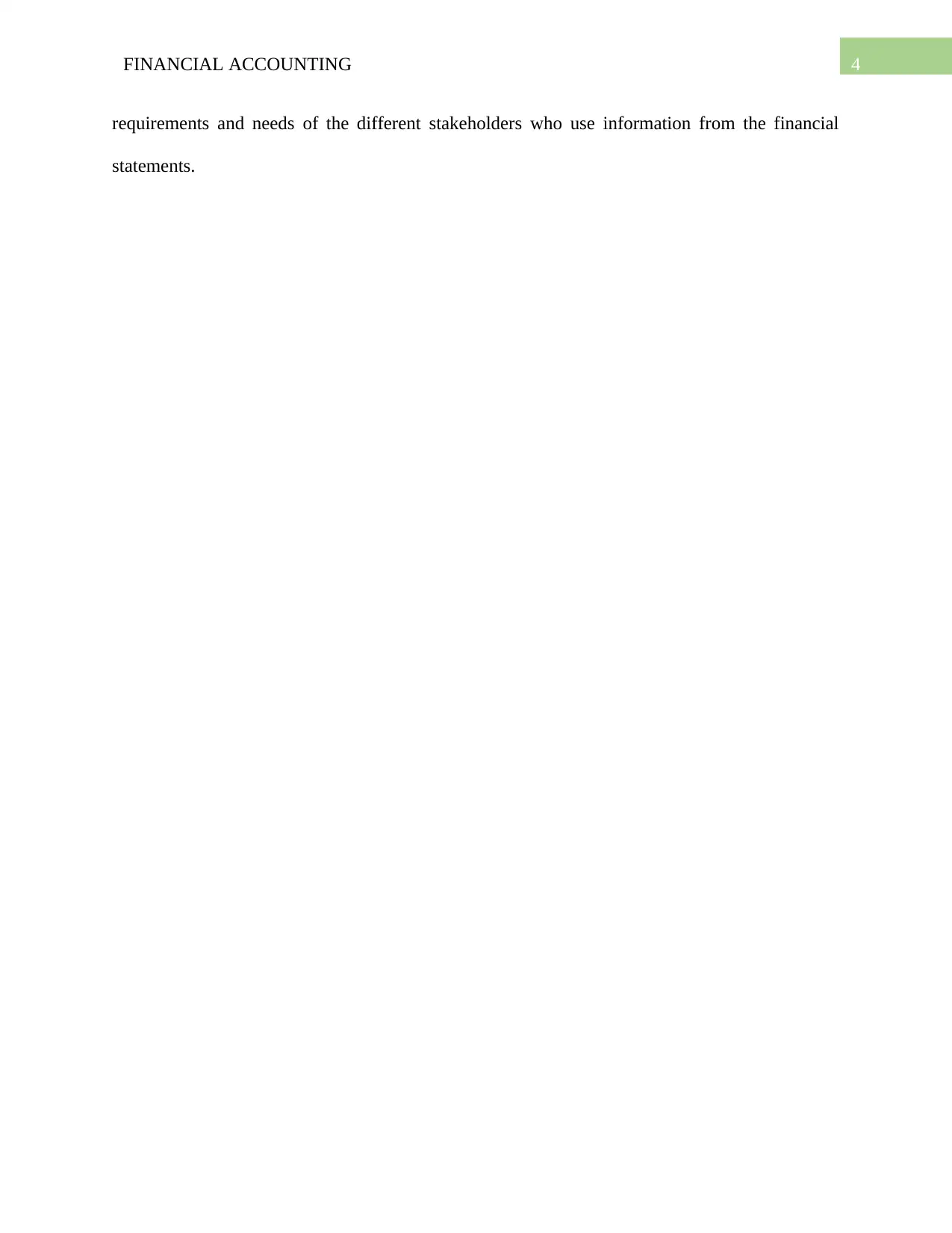
4FINANCIAL ACCOUNTING
requirements and needs of the different stakeholders who use information from the financial
statements.
requirements and needs of the different stakeholders who use information from the financial
statements.
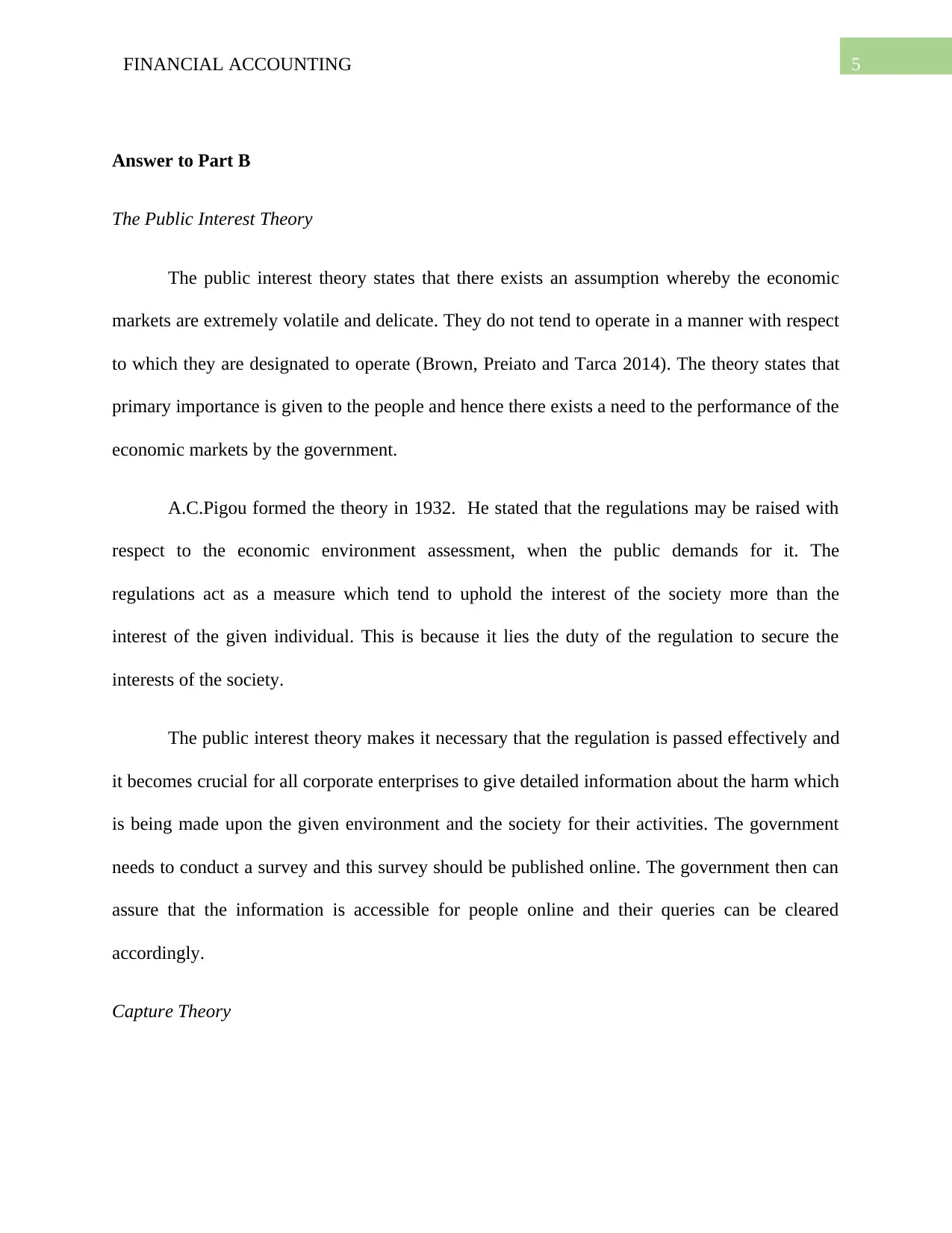
5FINANCIAL ACCOUNTING
Answer to Part B
The Public Interest Theory
The public interest theory states that there exists an assumption whereby the economic
markets are extremely volatile and delicate. They do not tend to operate in a manner with respect
to which they are designated to operate (Brown, Preiato and Tarca 2014). The theory states that
primary importance is given to the people and hence there exists a need to the performance of the
economic markets by the government.
A.C.Pigou formed the theory in 1932. He stated that the regulations may be raised with
respect to the economic environment assessment, when the public demands for it. The
regulations act as a measure which tend to uphold the interest of the society more than the
interest of the given individual. This is because it lies the duty of the regulation to secure the
interests of the society.
The public interest theory makes it necessary that the regulation is passed effectively and
it becomes crucial for all corporate enterprises to give detailed information about the harm which
is being made upon the given environment and the society for their activities. The government
needs to conduct a survey and this survey should be published online. The government then can
assure that the information is accessible for people online and their queries can be cleared
accordingly.
Capture Theory
Answer to Part B
The Public Interest Theory
The public interest theory states that there exists an assumption whereby the economic
markets are extremely volatile and delicate. They do not tend to operate in a manner with respect
to which they are designated to operate (Brown, Preiato and Tarca 2014). The theory states that
primary importance is given to the people and hence there exists a need to the performance of the
economic markets by the government.
A.C.Pigou formed the theory in 1932. He stated that the regulations may be raised with
respect to the economic environment assessment, when the public demands for it. The
regulations act as a measure which tend to uphold the interest of the society more than the
interest of the given individual. This is because it lies the duty of the regulation to secure the
interests of the society.
The public interest theory makes it necessary that the regulation is passed effectively and
it becomes crucial for all corporate enterprises to give detailed information about the harm which
is being made upon the given environment and the society for their activities. The government
needs to conduct a survey and this survey should be published online. The government then can
assure that the information is accessible for people online and their queries can be cleared
accordingly.
Capture Theory
⊘ This is a preview!⊘
Do you want full access?
Subscribe today to unlock all pages.

Trusted by 1+ million students worldwide
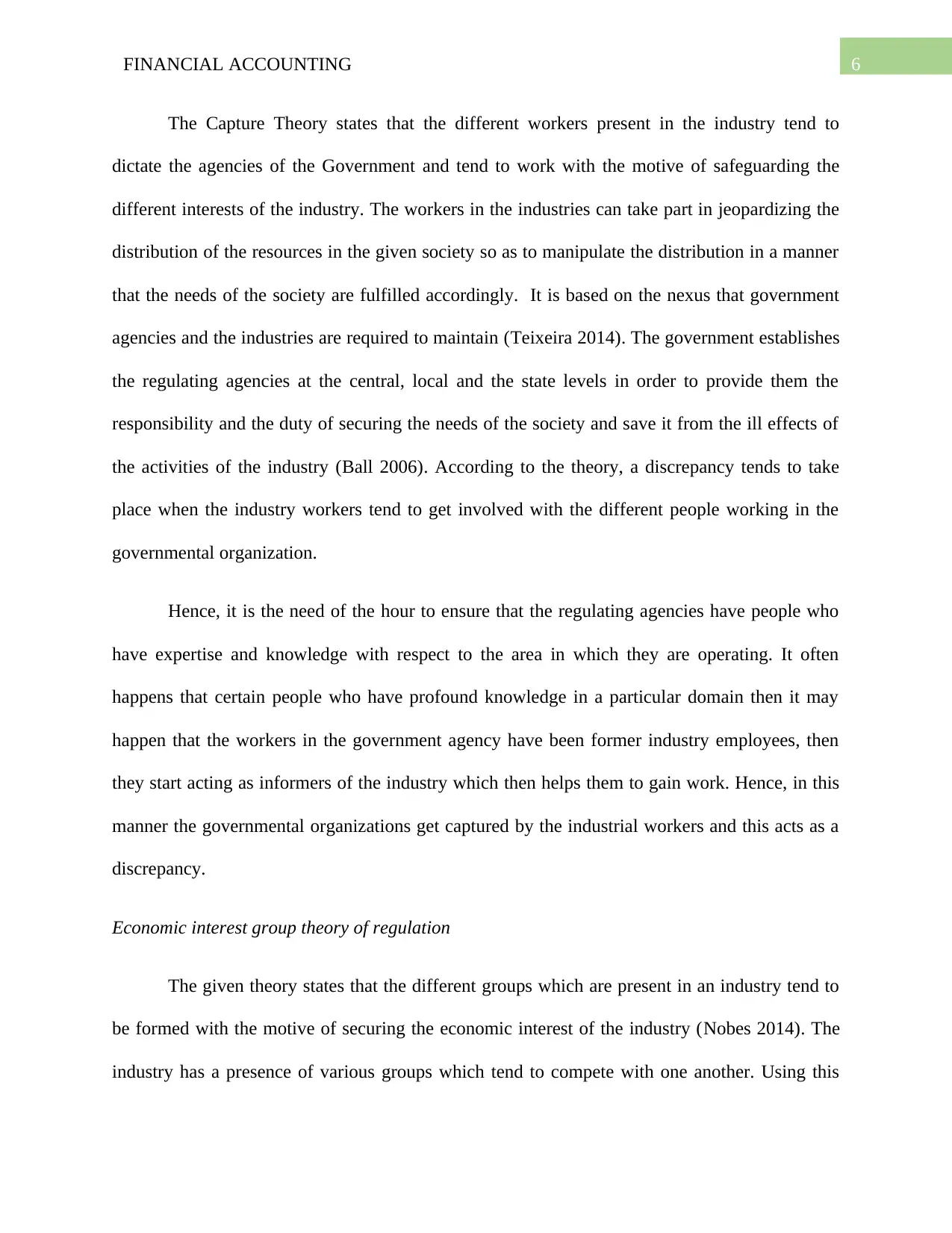
6FINANCIAL ACCOUNTING
The Capture Theory states that the different workers present in the industry tend to
dictate the agencies of the Government and tend to work with the motive of safeguarding the
different interests of the industry. The workers in the industries can take part in jeopardizing the
distribution of the resources in the given society so as to manipulate the distribution in a manner
that the needs of the society are fulfilled accordingly. It is based on the nexus that government
agencies and the industries are required to maintain (Teixeira 2014). The government establishes
the regulating agencies at the central, local and the state levels in order to provide them the
responsibility and the duty of securing the needs of the society and save it from the ill effects of
the activities of the industry (Ball 2006). According to the theory, a discrepancy tends to take
place when the industry workers tend to get involved with the different people working in the
governmental organization.
Hence, it is the need of the hour to ensure that the regulating agencies have people who
have expertise and knowledge with respect to the area in which they are operating. It often
happens that certain people who have profound knowledge in a particular domain then it may
happen that the workers in the government agency have been former industry employees, then
they start acting as informers of the industry which then helps them to gain work. Hence, in this
manner the governmental organizations get captured by the industrial workers and this acts as a
discrepancy.
Economic interest group theory of regulation
The given theory states that the different groups which are present in an industry tend to
be formed with the motive of securing the economic interest of the industry (Nobes 2014). The
industry has a presence of various groups which tend to compete with one another. Using this
The Capture Theory states that the different workers present in the industry tend to
dictate the agencies of the Government and tend to work with the motive of safeguarding the
different interests of the industry. The workers in the industries can take part in jeopardizing the
distribution of the resources in the given society so as to manipulate the distribution in a manner
that the needs of the society are fulfilled accordingly. It is based on the nexus that government
agencies and the industries are required to maintain (Teixeira 2014). The government establishes
the regulating agencies at the central, local and the state levels in order to provide them the
responsibility and the duty of securing the needs of the society and save it from the ill effects of
the activities of the industry (Ball 2006). According to the theory, a discrepancy tends to take
place when the industry workers tend to get involved with the different people working in the
governmental organization.
Hence, it is the need of the hour to ensure that the regulating agencies have people who
have expertise and knowledge with respect to the area in which they are operating. It often
happens that certain people who have profound knowledge in a particular domain then it may
happen that the workers in the government agency have been former industry employees, then
they start acting as informers of the industry which then helps them to gain work. Hence, in this
manner the governmental organizations get captured by the industrial workers and this acts as a
discrepancy.
Economic interest group theory of regulation
The given theory states that the different groups which are present in an industry tend to
be formed with the motive of securing the economic interest of the industry (Nobes 2014). The
industry has a presence of various groups which tend to compete with one another. Using this
Paraphrase This Document
Need a fresh take? Get an instant paraphrase of this document with our AI Paraphraser
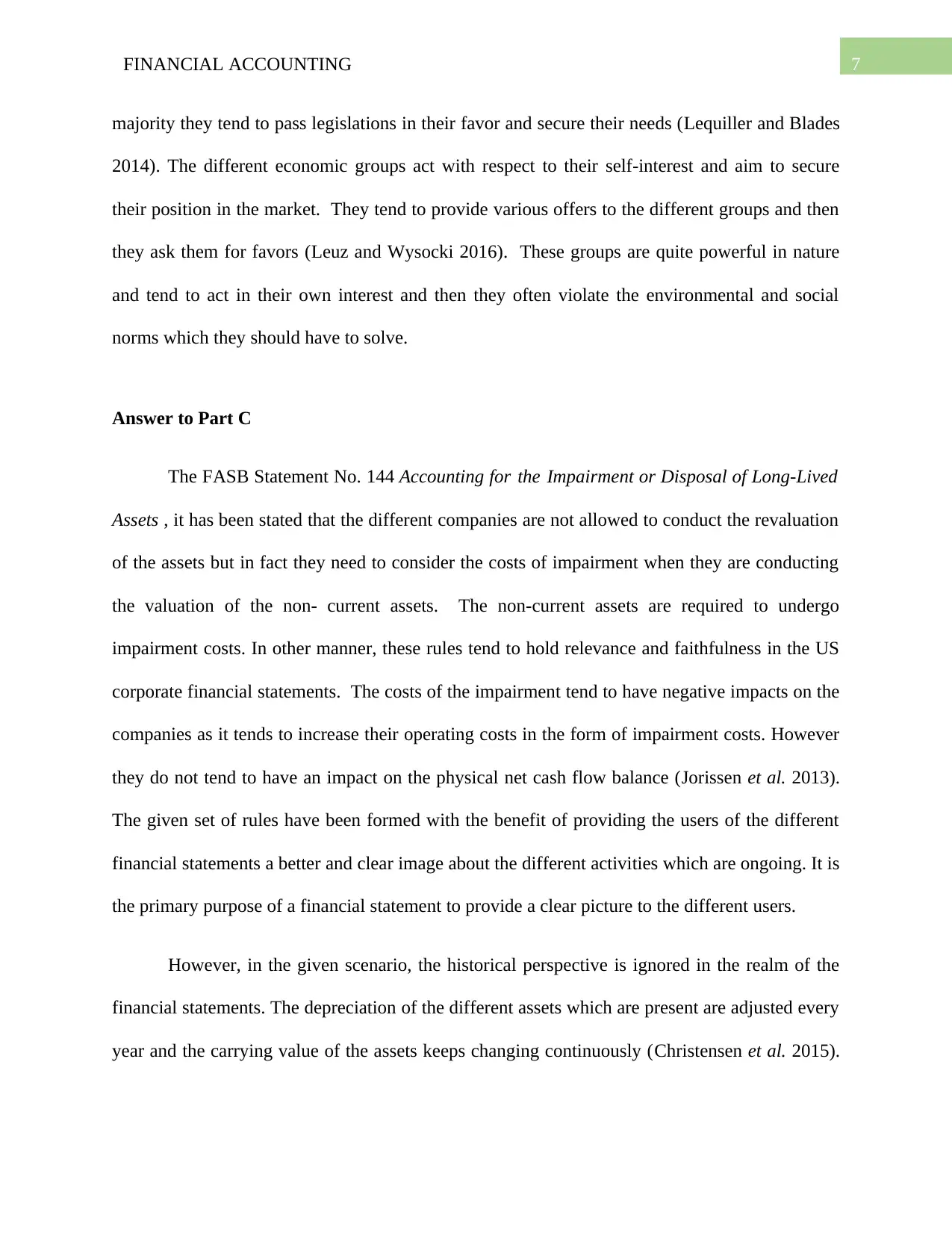
7FINANCIAL ACCOUNTING
majority they tend to pass legislations in their favor and secure their needs (Lequiller and Blades
2014). The different economic groups act with respect to their self-interest and aim to secure
their position in the market. They tend to provide various offers to the different groups and then
they ask them for favors (Leuz and Wysocki 2016). These groups are quite powerful in nature
and tend to act in their own interest and then they often violate the environmental and social
norms which they should have to solve.
Answer to Part C
The FASB Statement No. 144 Accounting for the Impairment or Disposal of Long-Lived
Assets , it has been stated that the different companies are not allowed to conduct the revaluation
of the assets but in fact they need to consider the costs of impairment when they are conducting
the valuation of the non- current assets. The non-current assets are required to undergo
impairment costs. In other manner, these rules tend to hold relevance and faithfulness in the US
corporate financial statements. The costs of the impairment tend to have negative impacts on the
companies as it tends to increase their operating costs in the form of impairment costs. However
they do not tend to have an impact on the physical net cash flow balance (Jorissen et al. 2013).
The given set of rules have been formed with the benefit of providing the users of the different
financial statements a better and clear image about the different activities which are ongoing. It is
the primary purpose of a financial statement to provide a clear picture to the different users.
However, in the given scenario, the historical perspective is ignored in the realm of the
financial statements. The depreciation of the different assets which are present are adjusted every
year and the carrying value of the assets keeps changing continuously (Christensen et al. 2015).
majority they tend to pass legislations in their favor and secure their needs (Lequiller and Blades
2014). The different economic groups act with respect to their self-interest and aim to secure
their position in the market. They tend to provide various offers to the different groups and then
they ask them for favors (Leuz and Wysocki 2016). These groups are quite powerful in nature
and tend to act in their own interest and then they often violate the environmental and social
norms which they should have to solve.
Answer to Part C
The FASB Statement No. 144 Accounting for the Impairment or Disposal of Long-Lived
Assets , it has been stated that the different companies are not allowed to conduct the revaluation
of the assets but in fact they need to consider the costs of impairment when they are conducting
the valuation of the non- current assets. The non-current assets are required to undergo
impairment costs. In other manner, these rules tend to hold relevance and faithfulness in the US
corporate financial statements. The costs of the impairment tend to have negative impacts on the
companies as it tends to increase their operating costs in the form of impairment costs. However
they do not tend to have an impact on the physical net cash flow balance (Jorissen et al. 2013).
The given set of rules have been formed with the benefit of providing the users of the different
financial statements a better and clear image about the different activities which are ongoing. It is
the primary purpose of a financial statement to provide a clear picture to the different users.
However, in the given scenario, the historical perspective is ignored in the realm of the
financial statements. The depreciation of the different assets which are present are adjusted every
year and the carrying value of the assets keeps changing continuously (Christensen et al. 2015).
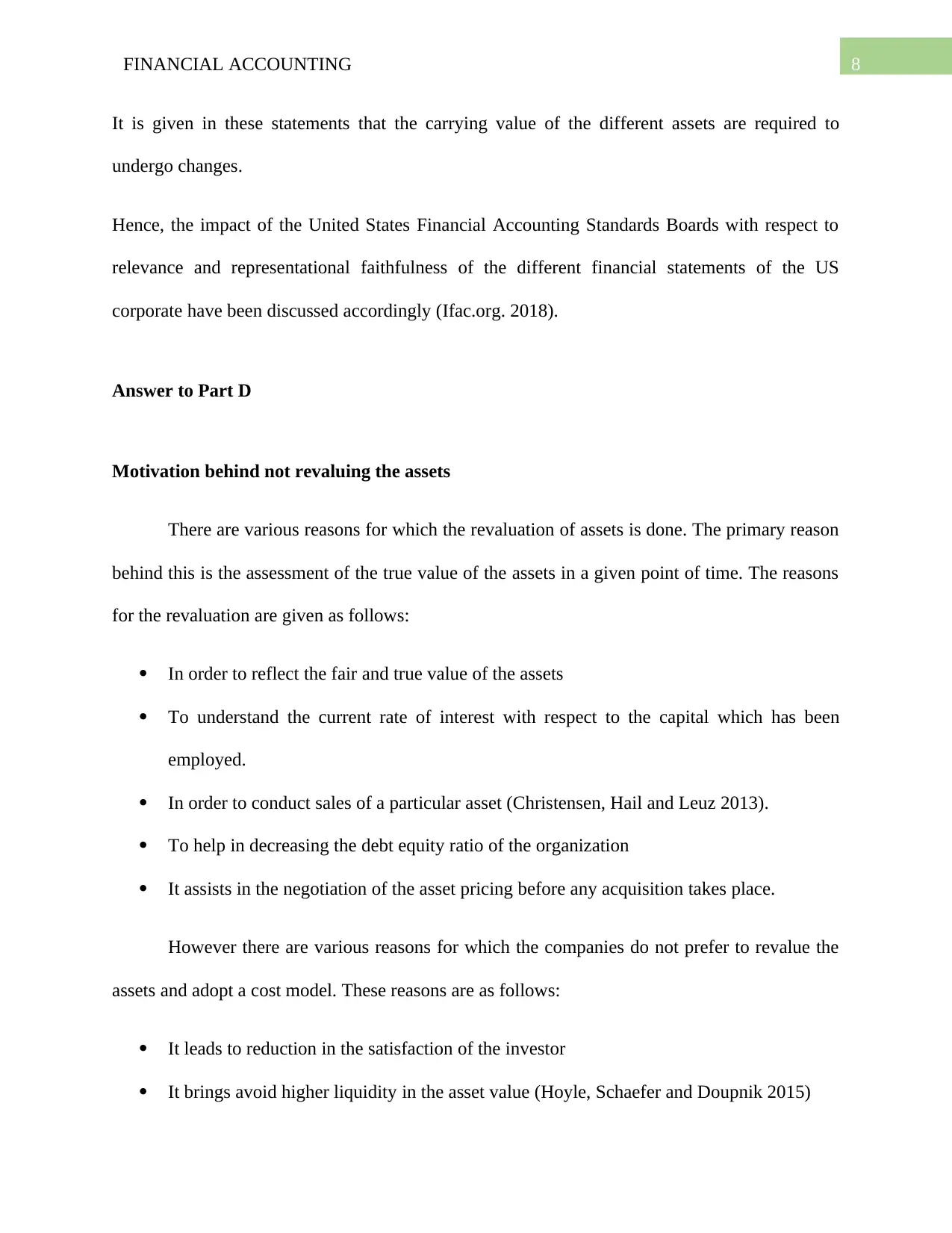
8FINANCIAL ACCOUNTING
It is given in these statements that the carrying value of the different assets are required to
undergo changes.
Hence, the impact of the United States Financial Accounting Standards Boards with respect to
relevance and representational faithfulness of the different financial statements of the US
corporate have been discussed accordingly (Ifac.org. 2018).
Answer to Part D
Motivation behind not revaluing the assets
There are various reasons for which the revaluation of assets is done. The primary reason
behind this is the assessment of the true value of the assets in a given point of time. The reasons
for the revaluation are given as follows:
In order to reflect the fair and true value of the assets
To understand the current rate of interest with respect to the capital which has been
employed.
In order to conduct sales of a particular asset (Christensen, Hail and Leuz 2013).
To help in decreasing the debt equity ratio of the organization
It assists in the negotiation of the asset pricing before any acquisition takes place.
However there are various reasons for which the companies do not prefer to revalue the
assets and adopt a cost model. These reasons are as follows:
It leads to reduction in the satisfaction of the investor
It brings avoid higher liquidity in the asset value (Hoyle, Schaefer and Doupnik 2015)
It is given in these statements that the carrying value of the different assets are required to
undergo changes.
Hence, the impact of the United States Financial Accounting Standards Boards with respect to
relevance and representational faithfulness of the different financial statements of the US
corporate have been discussed accordingly (Ifac.org. 2018).
Answer to Part D
Motivation behind not revaluing the assets
There are various reasons for which the revaluation of assets is done. The primary reason
behind this is the assessment of the true value of the assets in a given point of time. The reasons
for the revaluation are given as follows:
In order to reflect the fair and true value of the assets
To understand the current rate of interest with respect to the capital which has been
employed.
In order to conduct sales of a particular asset (Christensen, Hail and Leuz 2013).
To help in decreasing the debt equity ratio of the organization
It assists in the negotiation of the asset pricing before any acquisition takes place.
However there are various reasons for which the companies do not prefer to revalue the
assets and adopt a cost model. These reasons are as follows:
It leads to reduction in the satisfaction of the investor
It brings avoid higher liquidity in the asset value (Hoyle, Schaefer and Doupnik 2015)
⊘ This is a preview!⊘
Do you want full access?
Subscribe today to unlock all pages.

Trusted by 1+ million students worldwide
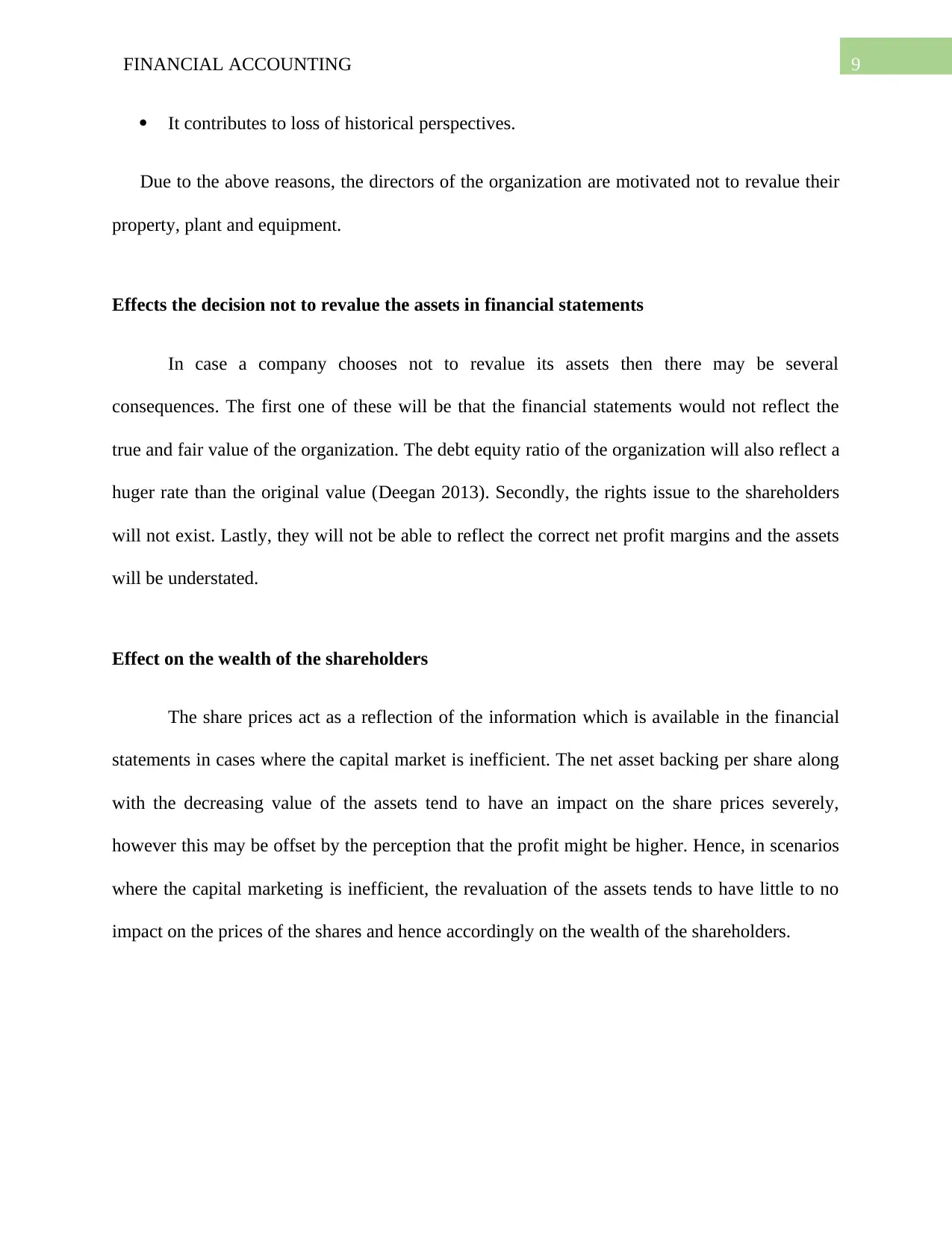
9FINANCIAL ACCOUNTING
It contributes to loss of historical perspectives.
Due to the above reasons, the directors of the organization are motivated not to revalue their
property, plant and equipment.
Effects the decision not to revalue the assets in financial statements
In case a company chooses not to revalue its assets then there may be several
consequences. The first one of these will be that the financial statements would not reflect the
true and fair value of the organization. The debt equity ratio of the organization will also reflect a
huger rate than the original value (Deegan 2013). Secondly, the rights issue to the shareholders
will not exist. Lastly, they will not be able to reflect the correct net profit margins and the assets
will be understated.
Effect on the wealth of the shareholders
The share prices act as a reflection of the information which is available in the financial
statements in cases where the capital market is inefficient. The net asset backing per share along
with the decreasing value of the assets tend to have an impact on the share prices severely,
however this may be offset by the perception that the profit might be higher. Hence, in scenarios
where the capital marketing is inefficient, the revaluation of the assets tends to have little to no
impact on the prices of the shares and hence accordingly on the wealth of the shareholders.
It contributes to loss of historical perspectives.
Due to the above reasons, the directors of the organization are motivated not to revalue their
property, plant and equipment.
Effects the decision not to revalue the assets in financial statements
In case a company chooses not to revalue its assets then there may be several
consequences. The first one of these will be that the financial statements would not reflect the
true and fair value of the organization. The debt equity ratio of the organization will also reflect a
huger rate than the original value (Deegan 2013). Secondly, the rights issue to the shareholders
will not exist. Lastly, they will not be able to reflect the correct net profit margins and the assets
will be understated.
Effect on the wealth of the shareholders
The share prices act as a reflection of the information which is available in the financial
statements in cases where the capital market is inefficient. The net asset backing per share along
with the decreasing value of the assets tend to have an impact on the share prices severely,
however this may be offset by the perception that the profit might be higher. Hence, in scenarios
where the capital marketing is inefficient, the revaluation of the assets tends to have little to no
impact on the prices of the shares and hence accordingly on the wealth of the shareholders.
Paraphrase This Document
Need a fresh take? Get an instant paraphrase of this document with our AI Paraphraser
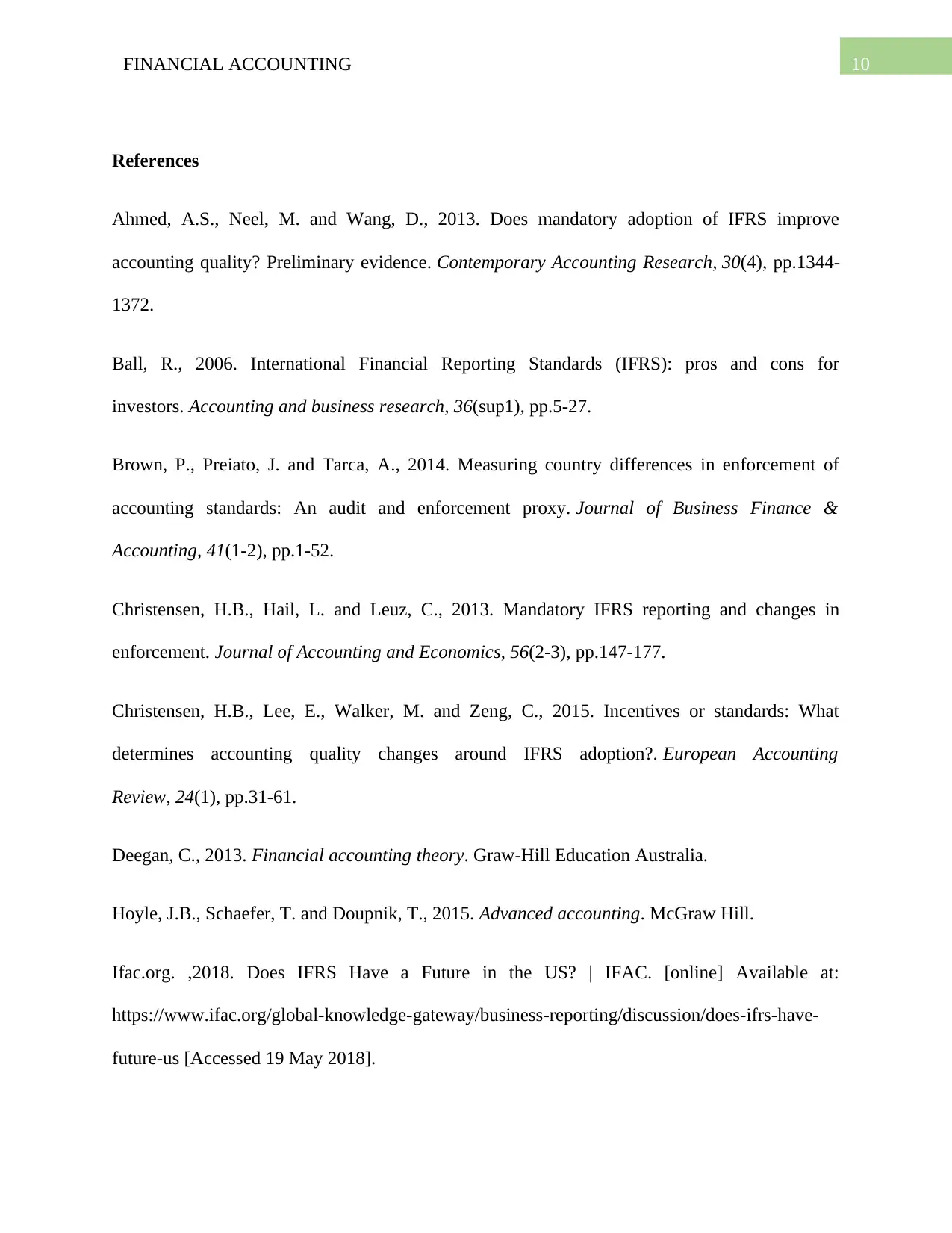
10FINANCIAL ACCOUNTING
References
Ahmed, A.S., Neel, M. and Wang, D., 2013. Does mandatory adoption of IFRS improve
accounting quality? Preliminary evidence. Contemporary Accounting Research, 30(4), pp.1344-
1372.
Ball, R., 2006. International Financial Reporting Standards (IFRS): pros and cons for
investors. Accounting and business research, 36(sup1), pp.5-27.
Brown, P., Preiato, J. and Tarca, A., 2014. Measuring country differences in enforcement of
accounting standards: An audit and enforcement proxy. Journal of Business Finance &
Accounting, 41(1-2), pp.1-52.
Christensen, H.B., Hail, L. and Leuz, C., 2013. Mandatory IFRS reporting and changes in
enforcement. Journal of Accounting and Economics, 56(2-3), pp.147-177.
Christensen, H.B., Lee, E., Walker, M. and Zeng, C., 2015. Incentives or standards: What
determines accounting quality changes around IFRS adoption?. European Accounting
Review, 24(1), pp.31-61.
Deegan, C., 2013. Financial accounting theory. Graw-Hill Education Australia.
Hoyle, J.B., Schaefer, T. and Doupnik, T., 2015. Advanced accounting. McGraw Hill.
Ifac.org. ,2018. Does IFRS Have a Future in the US? | IFAC. [online] Available at:
https://www.ifac.org/global-knowledge-gateway/business-reporting/discussion/does-ifrs-have-
future-us [Accessed 19 May 2018].
References
Ahmed, A.S., Neel, M. and Wang, D., 2013. Does mandatory adoption of IFRS improve
accounting quality? Preliminary evidence. Contemporary Accounting Research, 30(4), pp.1344-
1372.
Ball, R., 2006. International Financial Reporting Standards (IFRS): pros and cons for
investors. Accounting and business research, 36(sup1), pp.5-27.
Brown, P., Preiato, J. and Tarca, A., 2014. Measuring country differences in enforcement of
accounting standards: An audit and enforcement proxy. Journal of Business Finance &
Accounting, 41(1-2), pp.1-52.
Christensen, H.B., Hail, L. and Leuz, C., 2013. Mandatory IFRS reporting and changes in
enforcement. Journal of Accounting and Economics, 56(2-3), pp.147-177.
Christensen, H.B., Lee, E., Walker, M. and Zeng, C., 2015. Incentives or standards: What
determines accounting quality changes around IFRS adoption?. European Accounting
Review, 24(1), pp.31-61.
Deegan, C., 2013. Financial accounting theory. Graw-Hill Education Australia.
Hoyle, J.B., Schaefer, T. and Doupnik, T., 2015. Advanced accounting. McGraw Hill.
Ifac.org. ,2018. Does IFRS Have a Future in the US? | IFAC. [online] Available at:
https://www.ifac.org/global-knowledge-gateway/business-reporting/discussion/does-ifrs-have-
future-us [Accessed 19 May 2018].
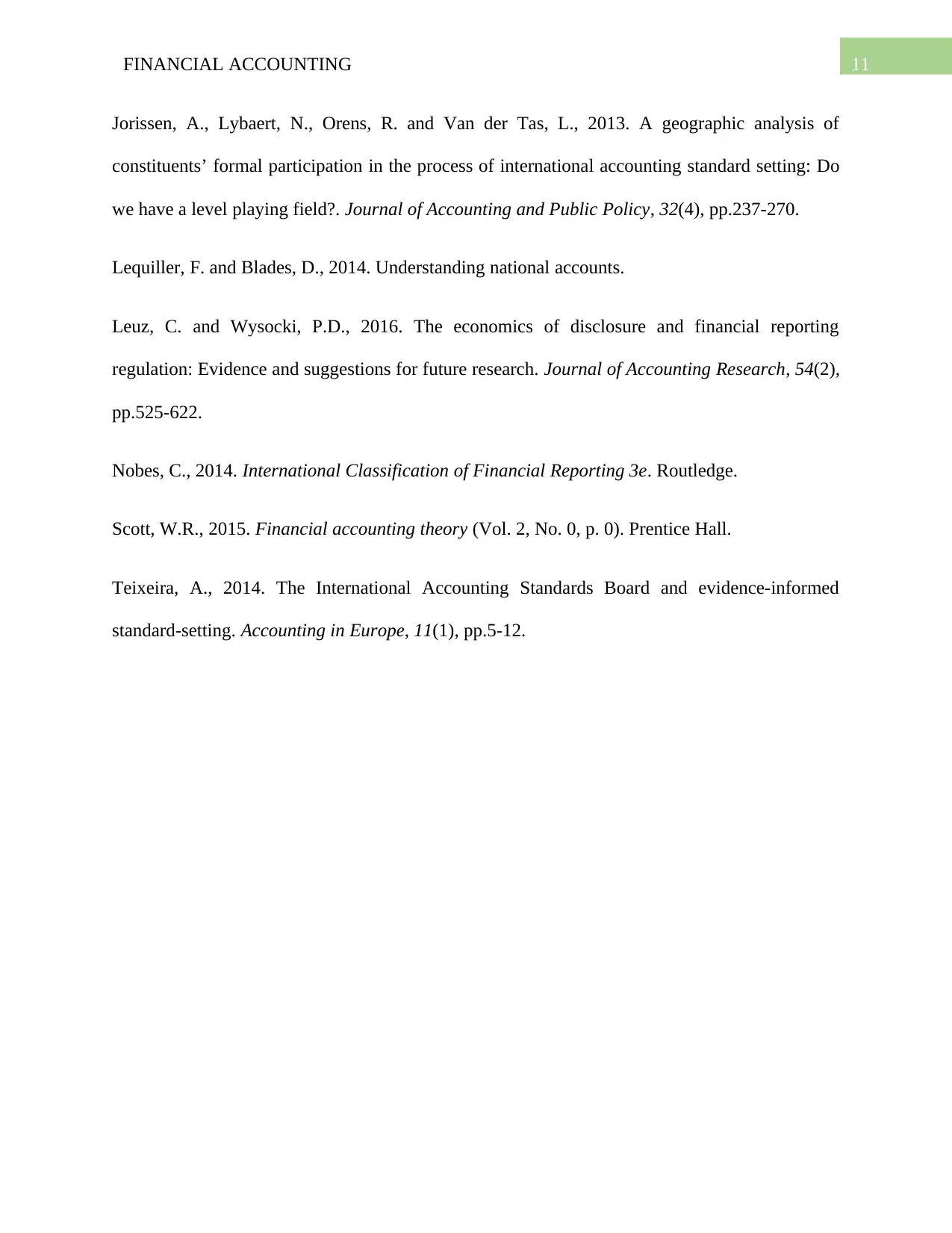
11FINANCIAL ACCOUNTING
Jorissen, A., Lybaert, N., Orens, R. and Van der Tas, L., 2013. A geographic analysis of
constituents’ formal participation in the process of international accounting standard setting: Do
we have a level playing field?. Journal of Accounting and Public Policy, 32(4), pp.237-270.
Lequiller, F. and Blades, D., 2014. Understanding national accounts.
Leuz, C. and Wysocki, P.D., 2016. The economics of disclosure and financial reporting
regulation: Evidence and suggestions for future research. Journal of Accounting Research, 54(2),
pp.525-622.
Nobes, C., 2014. International Classification of Financial Reporting 3e. Routledge.
Scott, W.R., 2015. Financial accounting theory (Vol. 2, No. 0, p. 0). Prentice Hall.
Teixeira, A., 2014. The International Accounting Standards Board and evidence-informed
standard-setting. Accounting in Europe, 11(1), pp.5-12.
Jorissen, A., Lybaert, N., Orens, R. and Van der Tas, L., 2013. A geographic analysis of
constituents’ formal participation in the process of international accounting standard setting: Do
we have a level playing field?. Journal of Accounting and Public Policy, 32(4), pp.237-270.
Lequiller, F. and Blades, D., 2014. Understanding national accounts.
Leuz, C. and Wysocki, P.D., 2016. The economics of disclosure and financial reporting
regulation: Evidence and suggestions for future research. Journal of Accounting Research, 54(2),
pp.525-622.
Nobes, C., 2014. International Classification of Financial Reporting 3e. Routledge.
Scott, W.R., 2015. Financial accounting theory (Vol. 2, No. 0, p. 0). Prentice Hall.
Teixeira, A., 2014. The International Accounting Standards Board and evidence-informed
standard-setting. Accounting in Europe, 11(1), pp.5-12.
⊘ This is a preview!⊘
Do you want full access?
Subscribe today to unlock all pages.

Trusted by 1+ million students worldwide
1 out of 12
Related Documents
Your All-in-One AI-Powered Toolkit for Academic Success.
+13062052269
info@desklib.com
Available 24*7 on WhatsApp / Email
![[object Object]](/_next/static/media/star-bottom.7253800d.svg)
Unlock your academic potential
Copyright © 2020–2025 A2Z Services. All Rights Reserved. Developed and managed by ZUCOL.




